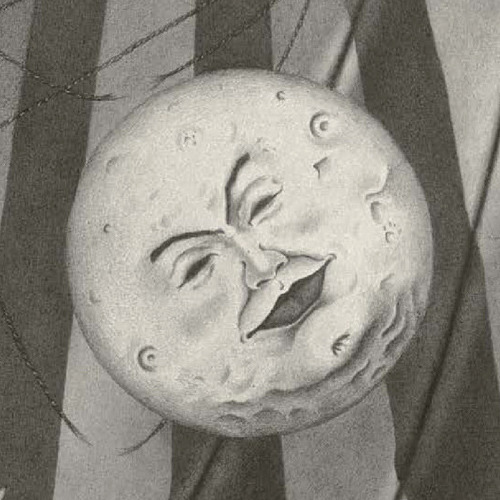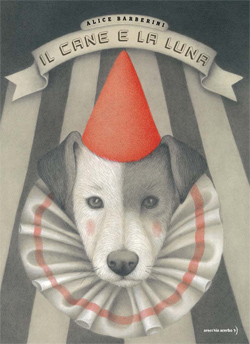< Back to posts
Alice Barberini
Italy

Alice Barberini studied art in Ravenna and art restoration in Florence. After working in an art restoration laboratory for a number of years, she set her sights on becoming a children's book illustrator. Alice is part of an illustration collective called Collettivo Nie Wiem and has exhibited her work all around Italy.
In this post, Alice talks about her debut picturebook, ‘Il cane e la luna’ (The dog and the moon), and she shares some beautiful illustrations and development work. This touching story is a homage to silent films, and is published by Orecchio Acerbo in Italy.
Alice: A couple of years ago, sitting at my worktable, I tried a new technique. Doodling with my pencil, I had the the desire to draw a dog. I was struck by a particular image in my mind: a little dog with a red hat and and a ruffled collar like a Pierrot mask. I drew him, I imagined a circus tent behind him, and without realising it, I already had a bit of the story and the cover of the book.
I was fond of the character straight away, and I tried portraying him in different positions. I began asking myself who he was, where he came from and where he was going. I let the drawing carry me away. I imagined him running away from a circus and sharing an adventure with an old cart and a papier-mâché moon.
“Why on Earth would a dog take a paper moon along?” I asked myself. Maybe he was running away from something or from a situation. I was certain that the little dog was in love with the moon. And perhaps he was running away precisely to save his beloved from a sad fate. I drew the moon several times. One of the drawings resembled Georges Méliès' moon from his silent film, ‘Le Voyage dans la Lune’, and I realised that the moon in the cart had to be ‘that moon’.
Reflecting on the psychological aspect of the characters, I realised that their relationship was a one-way street: the dog could love the moon, but the moon (being paper) could give the dog nothing in return. The little Pierrot deserved more: a delicate and innocent soul like his own. So I decided that a little boy, finding the sad and tired dog on a street corner, would take him home and look after him.
The dog would find his place in the world with the boy.
And the moon? She too had to have a destiny. In her own way, she also needed to be taken in. And I thought it could be Méliès himself who finds her and turns her into a film star.
A new place in the world for the moon as well as for the dog.
At first, when many facets of the book still needed to be defined, I tried writing the text, but without success. I had quite clear images and sequences in mind, but not the words. In my mind, the idea of doing a book without words pushed to the forefront. Thinking of Méliès and the reference to silent films, the need to make a book with no words took on more meaning.
I watched all the great filmmakers' short features again, along with some Chaplin films, especially ‘The Circus’. The earliest black-and-white films have always held an incredible and timeless fascination for me. I studied the camera shots and the graphic art of the text scenes of the silent films which I later decided to use in my book as well.
I designed the storyboard and prepared three finished pages. I used coloured pencils and graphite. Even though it required several hours of work, I really love this technique because it allows me great control over the shading; I can play with light and shadow, and I can pay close attention to the details. Then I prepared an introduction letter and sent everything to the publishing house, Orecchio Acerbo, which decided to publish the book.
The project – especially the final artwork – required several months, since the technique demands a lot of time and the book contains many pages.
‘The dog and the moon’ is my first book, and with it I discovered aspects of my creative process that I hadn't previously been aware of. I learnt, for example, that for me a new story begins much more easily with pictures than with words. In my mind, the images start to form a sequence like the frames of a film, even before the story begins.
Working without words (or nearly so), I enjoyed using the characters, shots and details to build the narrative. I discovered that the ‘silent book’ seems to be a faster read than the classic illustrated book. But in fact, in order to fully enjoy it the reader needs to linger on each of the illustrations, discovering the details and the feelings conveyed within the characters' body language. The reader allows the illustrations to silently carry him or her into the adventure.
Working on a book without words was a beautiful challenge that not only taught me a lot, but also allowed me to rediscover the powerful charm of storytelling through images alone – something that catches and surprises me every time in silent films.
Illustrations © Alice Barberini. Post translated by Gengo and edited by dPICTUS.
Il cane e la luna /
The dog and the moon
Alice Barberini
Orecchio Acerbo, Italy, 2015
A little circus dog has fallen in love with a paper moon hanging from the big top. It's a complicated love story. The paper moon is old and broken and she's ready to be thrown away. The little dog escapes from the circus with the moon in his cart – but once in the big city of Paris, he becomes lonely, hungry and cold... until a young boy finds him.
Thankfully, there’s a place in the world for the moon too: It’s 1902 and the elegant gentleman who finds her is Georges Méliès...














